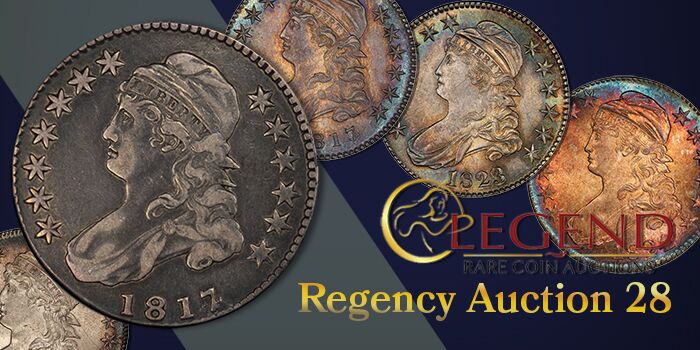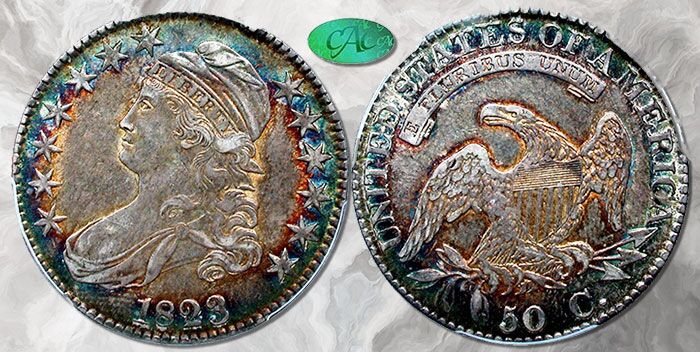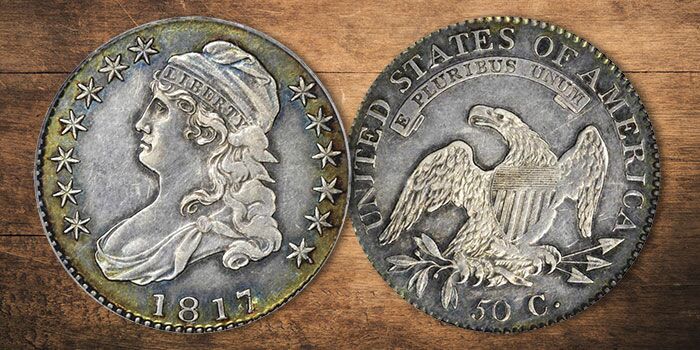
By Charles Morgan and Hubert Walker for CoinWeek Notes …..
Two half dollar series are called “Bust Halves”: the earlier Draped Bust type that ended in 1807 and the Capped Bust type that started in 1807 and ended in 1839. Capped Bust Half Dollars produced through 1836 have a lettered edge, but in 1836 the edge was changed to the familiar reeded style. Though there were subtle design changes after 1809 and others throughout the life of the series, it is the 1836 edge change that many numismatists use to separate the styles into two distinct types.
Half dollars in the early 1800s were the workhorse of circulating silver coinage; no silver dollars were minted from 1804 through 1835, and not in quantity until 1840. Produced using screw presses and with hand-punched elements on the dies, the Capped Bust Half Dollar series is known for many varieties that are of great collector interest.
The design is the work of German-born engraver John Reich, who immigrated to the United States as an indentured servant to escape the Napoleonic Wars. United States Mint Director Robert Patterson hired Reich to improve the design of this country’s coins; some have suggested that Reich based the Liberty portrait on his mistress, though that rumor has never been substantiated.
In only three years of the Capped Bust series did production drop below one million coins. No halves were produced in 1816 because a major fire at the Mint forced the suspension of all silver coinage. No Proofs are known until 1820, though rumors persist of samples produced as early as 1817.
How Much Are Capped Bust Half Dollars with a Lettered Edge Worth?
For nearly every date, but not necessarily every variety, several hundred coins are listed in the combined population reports of CAC, NGC, and PCGS. Coins are certified at grades from Very Fine to Superb Gem, though most cluster from Extremely Fine through near-Mint State. Significant numbers are available as Mint State up through near-Gem, but Gem and finer coins are scarce to rare. Prices are moderate through Choice AU but advance steeply afterward, particularly as Gem or finer.
Proofs are known from 1820 through 1836 and speculated for 1817 through 1819 though not confirmed. All Proofs are rare and expensive; in most years the total produced was fewer than 15 coins.
Extended Coverage on CoinWeek

Legend Rare Coin Auctions sold the Konstantine’s Capped Half Dollar Registry Set on September 26, 2018, and CoinWeek previewed some of the most spectacular highlights.

A few years ago, noted numismatist Gerry Fortin sold an exceptionally toned 1823 Capped Bust Half Dollar in Extra Fine condition for the impressive sum of $2,100. This article looks at why the coin achieved such a high price.
Rare U.S. coin expert and veteran dealer Jeff Garrett offers some tips on collecting the Lettered Edge type.

Q. David Bowers writes about the popular bur rare 1817/4 overdate variety and a curious influx of Capped Bust Half Dollars into circulation long after the series had ended.
And finally, coin expert and CoinWeek contributor Greg Reynolds analyses the Pogue specimen ‘Broken 3’ 1823 Capped Bust Half Dollar.
Counterfeit Detection

CoinWeek author Jack Young addresses a few Lettered Edge Capped Bust Half Dollars in his Fun With Fakes series on counterfeit coins he and the “Dark Side” group have discovered online.
Because the Mint used only one pair of dies to produce all half dollars in 1815, the 1815/2 overdate is a famously rare Capped Bust Half Dollar variety. NGC reports on an original 1815-dated coin that has been altered – a common, opportunistic form of counterfeiting.
Design
Obverse:
Reich’s elegant Liberty portrait covers most of the obverse. Facing to the left, Liberty wears a mobcap, described by Webster’s Dictionary as “a woman’s fancy indoor cap made with a high full crown and often tied under the chin.” The high crown of the hat is shown, folded over toward the front, but no tie appears on the coin. Across the bottom of the cap is the word LIBERTY, and cascades of curling hair drop down across the back and shoulder from under the cap. A flowing robe drapes across the bust, secured by a clasp on the shoulder. Thirteen six-pointed stars encircle inside a denticulated rim, seven to the left and six to the right. The date is at the bottom of the coin.
Reverse:
An imposing eagle is placed in the center of the reverse, head turned to the eagle’s right (viewer’s left), wings outstretched as if ready to fly, with a shield over the breast. Three arrows are held in the sinister claw (eagle’s left) and an olive branch in the dexter. The legend UNITED STATES OF AMERICA is placed around the top two-thirds of the coin inside a denticulated rim, with the denomination 50 C. at the bottom. A concentric banner, flat except for folded ends, is placed above the eagle below STATES OF and features the motto E PLURIBUS UNUM. No mintmark is shown; all were produced at Philadelphia.
Edge:
The edge displays the value of FIFTY CENTS OR HALF A DOLLAR. From 1814 through 1831 a star was added between DOLLAR and FIFTY, and from 1832 through 1836 vertical lines were added between the words.
Varieties
Varieties of the Lettered Edge Capped Bust Half Dollar are studied and collected by Overton numbers. Over 789 different dies have been identified. Varieties trading at higher price premiums are the 1812/1 Large 8; the 1815/2 mentioned above; the 1817/4 (quite expensive); and the 1830 Large Letters. The 1815/2 overdate is the only 1815-dated coin of the series, and fewer than 10 of the 1817/4 overdate are known. Many overdates, engraving errors, and letter and number size/shape variations have been catalogued, some represented in census/population reports by fewer than five examples.
Coin Specifications
| Capped Bust Half Dollar, Lettered Edge | |
| Years of Issue: | 1840-60 |
| Mintage (Circulation): | High: 6,545,000 (1836); Low: 47,150 (1815; all are the 1815/2 overdate) |
| Mintage (Proof): | High: 15 (1836, estimated); Low: 5 (1820-1824, estimated; none confirmed prior to 1820) |
| Alloy: | .900 silver, .100 copper |
| Weight: | ±13.48 g |
| Diameter: | ±32.50 mm |
| Edge: | Lettered |
| OBV Designer: | John Reich |
| REV Designer: | John Reich |
* * *
Additional References
Bowers, Q. David. The Experts Guide to Collecting and Investing in Rare Coins. Whitman Publishing.
–. A Guide Book of United States Type Coins. Whitman Publishing.
Breen, Walter. Walter Breen’s Encyclopedia of U.S. Coins. Doubleday.
Guth, Ron, and Jeff Garrett. United States Coinage: A Study by Type. Whitman Publishing.
Overton, Al. United States Early Half Dollar Varieties, 1794-1836. Donald L. Parsley.
Taxay, Don. The U.S. Mint and Coinage. Arco Publishing.
Yeoman, R.S., and Jeff Garrett (editor). The Official Red Book: A Guide Book of United States Coins. Whitman Publishing.
* * *


